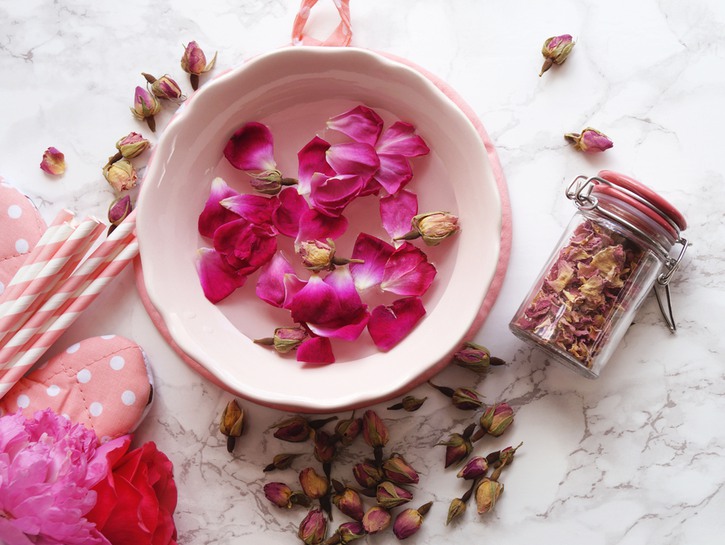Rosewater is a hydrosol, or floral water, made by steeping rose petals in distilled water. Although not as complex as a rose essential oil, rosewater is remarkably versatile with notable medicinal and culinary uses.
As they say, “A rose by any other name would smell as sweet.”Thick velvety petals sport a soft, romantic floral aroma. Roses taste similar to the way they smell: delicate, yet flowery, neither savory nor sweet. Yes, you read that right. You can actually use rose water to cook with!
Rosewater has also served as a trusted medicinal and beloved beauty ingredient for centuries. Today, you’ll find store shelves lined with rose water sprays and toners. From the best selling Mario Badescu Rosewater Facial Spray to Herbivore’s Rose Hibiscus Hydrating Mist, there is certainly no shortage of rosewater products. Yet, with rosewater’s growing popularity, many would be surprised to know how incredibly simple it is to prepare homemade rosewater in the comfort of your own kitchen. Once you make your own rosewater, you’ll wonder why you ever purchased it in the first place.
How to Make Rose Water

Simmering Method
The simmering method calls for fresh or dried roses to be directly simmered in water, resulting in aromatic rose-colored liquid. Considering the petals have simply been warmed in water, it’s not as pure as the distillation method, where impurities have been removed.
The easiest way to make rosewater is to use the simmering method, but is it the best choice? The simmering method will limit how it’s recommended that you use your rosewater and have a more fleeting shelf life.
Distillation Method
Although the distillation method takes slightly more time, it produces superior rose water, a hydrosol. A rose hydrosol differs from simple simmered rose water in that it appears clear, is shelf-stable, and is suitable for a variety of uses, such as cooking or cosmetics. On the other hand, simmered rose water would be ideal for freshening up a room or some tired linens.
Homemade Rose Water Recipe

Homemade Rose Water Recipe: Distillation Method
Please note that it is essential to choose organic roses for your rosewater recipe. Organic roses have pesticide-free rose petals, meaning your rosewater will be free of harmful chemicals. Unable to find organic flowers with your local florist? Purchase food-grade organic dried rose petals online.
Ingredients
- 3-5 cups fresh organic rose petals or 1 1/2 cups dried organic rose petals
- water
- ice cubes
Supplies
- large saucepan or stockpot with lid
- small heat-resistant bowl
- heat resistant silicone gloves or oven mitts
- glass container
Instructions
- Begin by removing the stems from the roses. Discard. Gently wash the rose petals, removing any impurities, such as dirt, dust, or unwanted insects from your rose petals.
- Place a small heat-resistant bowl in the center of a large saucepan or stockpot. Surround the bowl with clean rose petals.
- Pour water into the pot until the rose petals are fully submerged. Then heat the water to a gentle simmer.
- Once the water is simmering, place the lid onto the pot in an upside-down position. The lid will act as a bowl for ice.
- Add ice to the cover, about two cupfuls—as the ice melts continue to add more.
- In 30-45 minutes, rose water will have condensed into the bowl placed into the center of your pot. You can carefully remove this bowl with heat-resistant silicone gloves or oven mitts.
- Transfer your rose water to a glass container and store it in a cool, dry place or in the refrigerator for up to six months.
History of Rose Water

Rosewater has been around for centuries, originating from Persia. As the crusades toured through Europe, the Middle East’s flavors eventually found their way to western society. A flavor widely used in homes before vanilla took center stage, rosewater was easily accessible, with roses abundantly growing in family gardens.
Rose is a part of many fruit families, so it’s no surprise that its strikingly unique floral flavor simply shines when paired with spring and summer fruits. Yet, sadly, the debut of vanilla overshadowed the once-popular rosewater and took the flavoring crown.
Benefits of Rose Water

The benefits of rosewater are boundless! Not only does rosewater have both medicinal and culinary qualities, but it can also be added to your beauty routine. The medicinal effects of rosewater are widespread. Here’s a few:
Skin
Rosewater is remarkably soothing for troubled skin with its anti-inflammatory properties. Rosewater will help cool and comfort burning, as well as reduce redness and irritation. Rosewater is also the answer to anti-aging, as it reduces the appearance of fine lines and wrinkles. Perhaps why the best-selling KORRES Apothecary Wild Rose skincare collection is so widely popular!
Wound Healing
Rosewater is considered to have antiseptic and antibacterial properties, making it possible for it to help wounds heal faster, such as minor cuts or burns.
Mood Enhancer
Studies have shown that rosewater has antidepressant and anti-anxiety properties. These effects are said to be quite similar to the pharmaceutical drug Diazepam.
Headaches
Aromatherapy, when it comes to rose has some promising effects. Those that suffer from headaches looking for natural remedies can inhale rosewater for relief. Alternatively, rosewater can be applied to a facecloth and placed onto the forehead when one wants to sit back and relax.
Digestion
Bathroom troubles? Rosewater can cure those woes too. Studies have shown that rosewater when ingested increases bile flow which can soothe a constellation of common digestive complaints, from an upset stomach to constipation.
